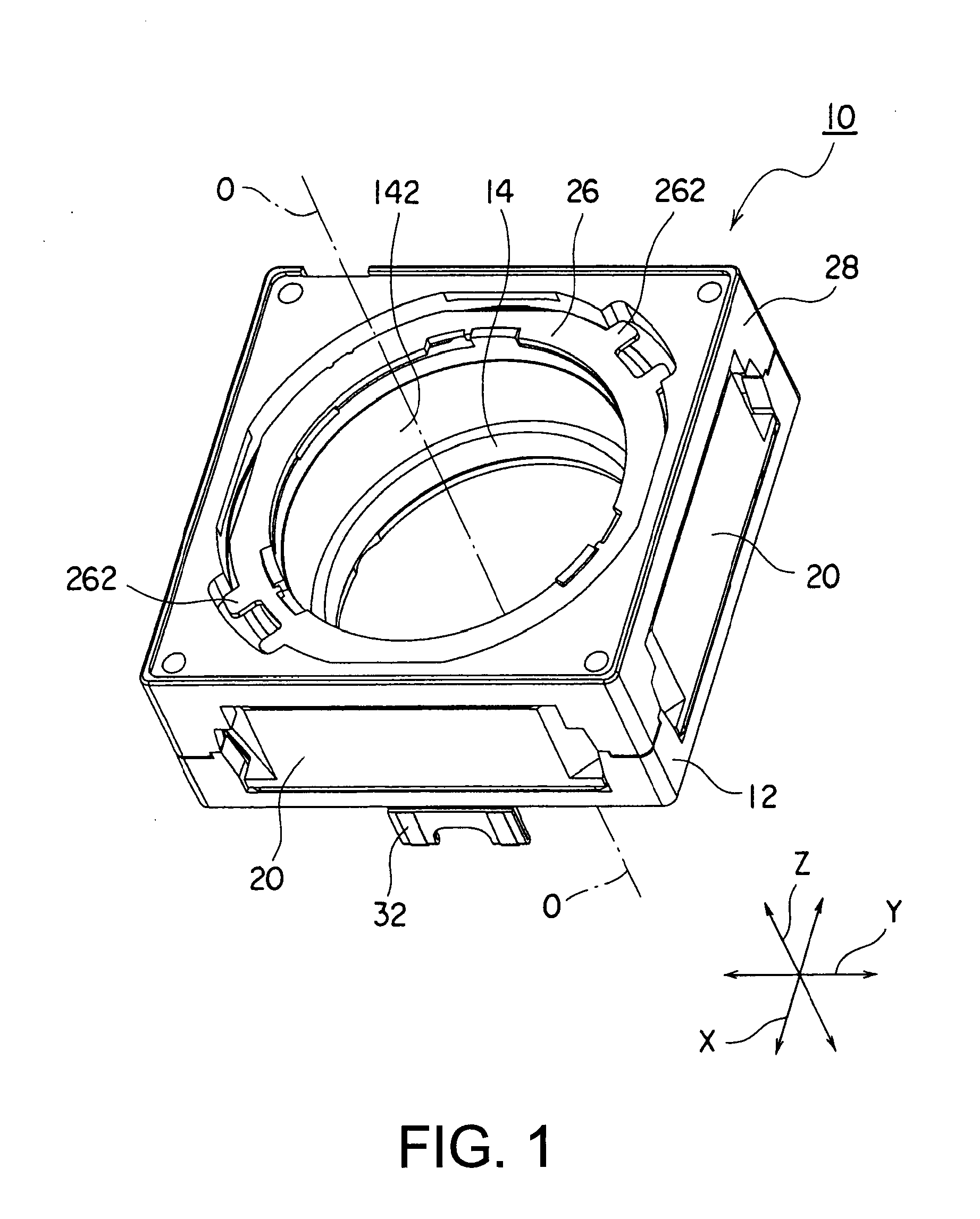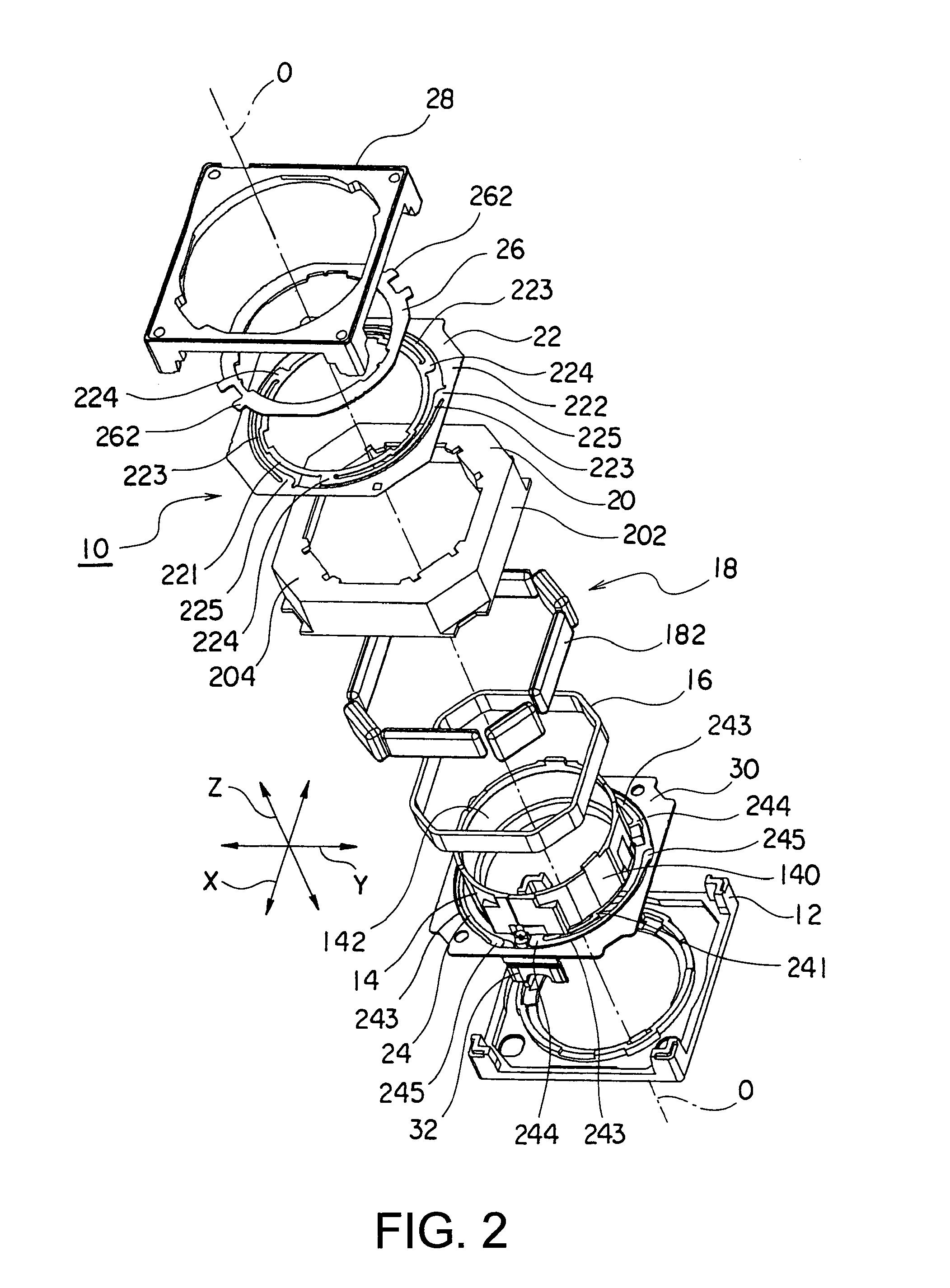Leaf spring with high vickers hardness
a technology of vickers and leaf springs, applied in the direction of springs/dampers, mountings, instruments, etc., can solve the problems of highly poisonous beryllium compounds and detrimental effects on the performance of the lens driving device, and achieve the effect of improving both the performance of lens inclination (tilt) and the performance of impact resistan
- Summary
- Abstract
- Description
- Claims
- Application Information
AI Technical Summary
Benefits of technology
Problems solved by technology
Method used
Image
Examples
first exemplary embodiment
[0044]Referring to FIGS. 1 and 2, the description will proceed to a lens driving device 10 according to a first exemplary embodiment of this invention. FIG. 1 is a perspective view of the lens driving device 10. FIG. 2 is an exploded perspective view of the lens driving device 10.
[0045]Herein, in the manner shown in FIGS. 1 and 2, an orthogonal coordinate system (X, Y, Z) is used. In a state illustrated in FIGS. 1 and 2, in the orthogonal coordinate system (X, Y, X), an X-axis direction is a fore-and-aft direction (a depth direction), a Y-axis direction is a left-and-right direction (a width direction), and a Z-axis direction is an up-and-down direction (a height direction). In addition, in the example being illustrated in FIGS. 1 and 2, the up-and-down direction Z is a direction of an optical axis O of a lens.
[0046]However, in an actual use situation, the direction of the optical axis O, namely, the Z-axis direction becomes a fore-and-aft direction. In other words, an upper directi...
example 1
[0069]A first example of the present invention uses, as the material of the leaf springs (22, 24), high hardness non-magnetic stainless steel having high Vickers hardness by cold working that is less than 500 (HV) and which has low permeability. Such stainless steel can use, for example, NTK S-4 made in Nippon Metal Industry Co., Ltd (NIKKINKO). Chemical component (mass %) of the NTK S-4 is shown in as FIG. 3.
[0070]The high hardness non-magnetic stainless steel has relative magnetic permeability of about 1.002.
[0071]Although a row workpiece thereof has low Vickers hardness of 260 (HV), it is possible to rise the Vickers hardness up to 500 (HV) or more by applying cold working as shown in FIG. 4. In FIG. 4, a horizontal axis represents a rate (%) of the cold working while a vertical axis represents Vickers hardness (HV).
[0072]Now, the description will proceed to a method of manufacturing the row workpiece (thin plate) of the leaf spring by cold rolling. First, by using a row workpiec...
example 2
[0077]A second example of the present invention uses, as the material of the leaf springs (22, 24), high hardness stainless steel (austenitic chromium-nickel steel) having high Vickers hardness by cold working that is less than 500 (HV). Such stainless steel can use, for example, NTK 301 (SUS301) made in Nippon Metal Industry Co., Ltd (NIKKINKO). Chemical component (mass %) of the NTK 301 is shown in as FIG. 6.
[0078]The high hardness stainless steel has relative magnetic permeability of about 1.50.
[0079]Although a row workpiece thereof has low Vickers hardness of 191 (HV), it is possible to rise the Vickers hardness up to 500 (HV) or more by applying cold working as shown in FIG. 7. In FIG. 7, a horizontal axis represents a rate (%) of the cold working while a vertical axis represents Vickers hardness (HV).
[0080]Inasmuch as a method of manufacturing the row workpiece (thin plate) of the leaf spring by cold rolling is similar to that of the above-mentioned first embodiment, the descr...
PUM
 Login to View More
Login to View More Abstract
Description
Claims
Application Information
 Login to View More
Login to View More - R&D
- Intellectual Property
- Life Sciences
- Materials
- Tech Scout
- Unparalleled Data Quality
- Higher Quality Content
- 60% Fewer Hallucinations
Browse by: Latest US Patents, China's latest patents, Technical Efficacy Thesaurus, Application Domain, Technology Topic, Popular Technical Reports.
© 2025 PatSnap. All rights reserved.Legal|Privacy policy|Modern Slavery Act Transparency Statement|Sitemap|About US| Contact US: help@patsnap.com



